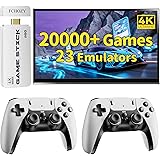Have you ever found yourself in the middle of an intense gaming session, only to be let down by a unresponsive mouse, an uncomfortable headset, or a keyboard that just doesn’t quite keep up? The pursuit of the perfect gaming experience is often a journey of small, incremental upgrades. While raw PC power or console specifications are frequently highlighted, the crucial role played by high-quality gaming accessories can sometimes be overlooked. These peripherals are the direct interface between a player and their virtual world, making a significant impact on both performance and enjoyment.
The video above likely touches upon several key pieces of equipment that can elevate your gameplay. However, a deeper dive into these vital components reveals just how much strategic thought is invested in their design and functionality. Optimizing your setup with the right gaming accessories is not merely about accumulating expensive gear; rather, it is about creating an immersive, responsive, and ergonomic environment that enhances every moment spent gaming.
Optimizing Your Gaming Setup: Beyond the Core Components
The foundation of any formidable gaming rig lies in its core processing units, but the peripherals surrounding these powerful machines are what truly bring the experience to life. A comprehensive suite of gaming accessories is typically considered indispensable for those aiming for a competitive edge or simply seeking maximum comfort during extended play. These tools are meticulously designed to reduce latency, improve precision, and provide a greater degree of control than standard equipment.
When considering an upgrade, various factors are usually taken into account, ranging from personal playstyle to budget constraints. It is generally understood that each accessory contributes uniquely to the overall gaming ecosystem. Consequently, careful selection is often emphasized, ensuring that each component complements the others effectively to form a cohesive and powerful setup.
Precision and Control: Gaming Mice and Keyboards
For PC gamers, the mouse and keyboard are undeniably the primary instruments of interaction. These critical gaming accessories are responsible for every movement, every shot, and every command executed in a game. The distinction between a standard office peripheral and a dedicated gaming variant is frequently observed to be substantial, influencing accuracy and reaction times.
A gaming mouse, for instance, is typically characterized by a high DPI (dots per inch) sensor, which allows for extreme sensitivity and tracking precision. Adjustable DPI settings are often included, enabling players to switch sensitivity on the fly to suit different in-game situations, from pixel-perfect sniping to rapid movements. Furthermore, a high polling rate, measured in Hz, ensures that the mouse’s position updates are sent to the computer more frequently, thereby reducing input lag. Ergonomic designs, customizable buttons, and durable switches are also common features, providing both comfort and longevity during countless hours of use.
Similarly, gaming keyboards are engineered with performance in mind. Mechanical keyboards, in particular, are favored for their tactile feedback and quicker actuation points compared to their membrane counterparts. This allows for faster, more responsive key presses, which is often crucial in fast-paced titles. Anti-ghosting and N-key rollover capabilities are frequently incorporated, ensuring that multiple simultaneous key presses are registered accurately, preventing frustrating missed commands during intense gameplay. Programmable macro keys also provide a distinct advantage, allowing complex sequences of actions to be executed with a single press.
Immersive Audio: The Power of Gaming Headsets
Sound is a critical component of immersion and tactical awareness in gaming. A quality gaming headset is not just about clear communication with teammates; it is also pivotal for spatial audio cues that can dictate success or failure in many titles. The ability to accurately pinpoint enemy locations based on footsteps or distant gunfire provides a significant competitive advantage, which is often highlighted by professional gamers.
Gaming headsets are typically equipped with larger drivers for richer sound profiles, often tuned to emphasize in-game audio cues like explosions and speech, while also offering crisp highs and deep bass. Surround sound technologies, whether virtual (like 7.1 surround sound) or true, are frequently integrated to create a more expansive and directionally accurate soundscape. Comfort is another key consideration, with lightweight designs, adjustable headbands, and breathable earcups being standard features for extended wear. Noise-cancelling microphones are also commonly included, ensuring clear voice communication without background distractions, which is crucial for coordinated team play.
Visual Superiority: Gaming Monitors and Displays
While often categorized as a core component rather than a mere accessory, the monitor is undeniably the window into the game world and its performance heavily influences the overall gaming experience. The impact of a high-refresh-rate monitor, for example, cannot be overstated for its ability to display more frames per second, resulting in smoother motion and reduced visual tearing. This fluidity is often perceived as a significant advantage in competitive titles, allowing for quicker reactions to on-screen events.
Key specifications that are frequently considered include refresh rate (e.g., 144Hz, 240Hz, 360Hz) and response time (e.g., 1ms GTG). A higher refresh rate coupled with a low response time ensures that images are updated more rapidly and with minimal blurring. Adaptive sync technologies, such as NVIDIA G-SYNC or AMD FreeSync, are also commonly found, which synchronize the monitor’s refresh rate with the GPU’s output, thereby eliminating screen tearing and stuttering. Panel types (IPS, VA, TN) are also factors, each offering different trade-offs in terms of color accuracy, viewing angles, and response times, allowing players to choose based on their priorities.
Ergonomics and Comfort: Gaming Chairs and Controllers
Long gaming sessions demand more than just technical performance; they also require sustained comfort and proper posture. A dedicated gaming chair is frequently recommended to alleviate strain and promote better ergonomics, contrasting sharply with standard office chairs that are not designed for the specific postures adopted during intense play. These chairs often feature high backs, adjustable armrests, lumbar support, and neck pillows, all intended to provide comprehensive support for the spine and limbs.
Furthermore, for console gamers or PC users who prefer an alternative input method, a specialized gaming controller is often chosen over the standard bundled options. These controllers might feature additional programmable buttons, customizable triggers, enhanced grip textures, or modular components that can be swapped to suit individual preferences. The subtle enhancements offered by these advanced controllers can significantly improve responsiveness and comfort, especially in genres like fighting games or racing simulations where precise analog input is valued.
Enhancing the Ecosystem: Supporting Gaming Accessories
Beyond the primary peripherals, a host of other gaming accessories contribute to a fully optimized setup. These often overlooked items can nonetheless make a considerable difference in convenience, aesthetics, and overall performance. For example, a quality gaming mouse pad, with its optimized surface for tracking precision, is typically considered a necessary complement to a high-DPI mouse.
Cable management solutions, such as cable ties and routing channels, are frequently employed to maintain a tidy and organized desk space, which can prevent accidental disconnections and improve airflow. External sound cards or DACs (Digital-to-Analog Converters) are sometimes introduced to enhance audio quality beyond what integrated motherboard solutions can offer, providing clearer sound reproduction and amplification for high-end headsets. Even seemingly minor additions, like USB hubs for connecting multiple devices or monitor arms for ergonomic positioning, are often considered valuable for streamlining the gaming environment. All these elements, taken together, contribute to a superior and more focused gaming experience, allowing players to concentrate on the game without external distractions or discomfort.









